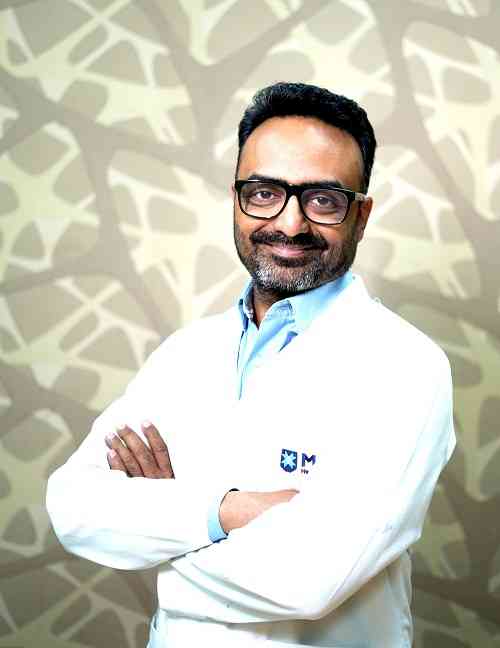Regenerative Medicine: A Game Changer in Orthopedic Care
Regenerative medicine is a rapidly evolving field that is transforming orthopaedic care. This field encompasses a wide range of treatments and technologies aimed at repairing or replacing damaged or diseased tissues in the body with the goal of restoring normal function and reducing pain. In the field of orthopaedics, regenerative medicine is proving to be a game-changer, offering new options for patients In the field of orthopaedics, regenerative medicine is proving to be a game-changer, offering new options for patients with conditions ranging from joint pain and osteoarthritis to traumatic injuries and degenerative conditions. Regenerative medicine refers to the use of advanced therapies and treatments to promote the healing and regrowth of damaged or lost tissue in bones, joints, and muscles.

by Dr. Achal Saradava, Arthroscopy And Joint Replacement Surgeon. HCG Hospitals Rajkot
Regenerative medicine is a rapidly evolving field that is transforming orthopaedic care. This field encompasses a wide range of treatments and technologies aimed at repairing or replacing damaged or diseased tissues in the body with the goal of restoring normal function and reducing pain. In the field of orthopaedics, regenerative medicine is proving to be a game-changer, offering new options for patients In the field of orthopaedics, regenerative medicine is proving to be a game-changer, offering new options for patients with conditions ranging from joint pain and osteoarthritis to traumatic injuries and degenerative conditions. Regenerative medicine refers to the use of advanced therapies and treatments to promote the healing and regrowth of damaged or lost tissue in bones, joints, and muscles.
The use of regenerative medicine in orthocare
Platelet rich plasma therapy: Regenerative medicine in orthopaedics also includes the use of platelet-rich plasma (PRP) therapy. PRP is a concentrated solution of platelets and growth factors that is derived from a patient's own blood. When injected into the damaged area, PRP has the ability to promote healing and regeneration by stimulating the growth of new tissue. PRP therapy is commonly used to treat conditions such as tendinitis, ligament sprains, muscle strains, Arthritis of various joints and bony nonunion after a fracture.
Biologic scaffold: Another exciting area of regenerative medicine in orthopaedics is the use of biologic scaffolds. Biologic scaffolds are made from natural or synthetic materials that are designed to mimic the structure and function of native tissues. They are often used to provide support for new tissue growth and to promote healing in the damaged area. Biologic scaffolds can be used in a wide range of orthopaedic conditions, including rotator cuff tears, knee ligament injuries, spinal cord injuries and Cartilage damage in joints.
Regenerative injections: Regenerative medicine is also redefining orthopaedic care through the use of regenerative injections. Regenerative injections are a minimally invasive procedure that involves injecting a variety of biologic products, such as PRP directly into the damaged area. These injections have the ability to promote healing and reduce pain and inflammation, making them a valuable tool in the management of orthopaedic conditions.
Why regenerative medicine is beneficial for orthopaedic patients
Leads to faster and efficient healing: One of the key benefits of regenerative medicine in orthopaedics is its ability to promote faster and more effective healing. Traditional orthopaedic treatments, such as surgery or physical therapy, may help manage pain and improve function, but they do not always address the underlying cause of the injury or degeneration. Regenerative medicine, on the other hand, uses a variety of approaches to stimulate the body's natural healing process, helping to repair or replace damaged tissue and improve overall function and quality of life.
Minimally invasive: Another key benefit of regenerative medicine in orthopaedics is its potential to reduce the need for invasive treatments, such as surgery. In many cases, regenerative therapies can be performed in a minimally invasive manner, without the need for major incisions or hospitalisation. This can result in quicker recovery times and lower risk of complications, such as infection or scarring.
Reduces pain management need: Regenerative treatments may help reduce the need for ongoing pain management medications or physical therapy.
Heals patients who haven’t got optimal results from traditional treatments: One of the most exciting aspects of regenerative medicine in orthopaedics is its potential to provide new hope to those who have not found relief from their symptoms through traditional treatments. For example, regenerative treatments may be an option for patients with degenerative joint conditions, such as osteoarthritis, who have exhausted all other options for pain relief.
In orthopaedics, regenerative medicine offers a promising new approach to treating musculoskeletal conditions. It is a game-changing approach in the field of orthopaedics because of its ability to promote faster healing and reduce the need for invasive treatments. One can reach out to the expert Orthopedic surgeon and Rheumatologist at HCG Multispecialty Hospital to get more informed on regenerative medicine for ortho care and opt for it for enhanced treatment outcomes.


 City Air News
City Air News 







